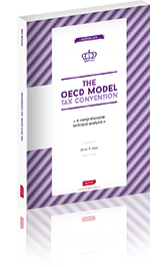The volume of cross-border transactions realized by individuals and enterprises has soared dramatically in recent years amid an increasingly globalized economy. In these circumstances, taxpayers are frequently subject to tax in two (or more) jurisdictions which is an obstacle to international trade and investment.
Bilateral tax treaties are an efficient tool to eliminate double taxation and promoting the development of economic ties between countries. Most tax treaties worldwide are based on the OECD’s Model Convention with respect to taxes on income and on capital and follow both its structure and wording. Its objective is the harmonization of tax treaties concluded by OECD member states through clarification and standardization; thereby resulting in common solutions being applied by all countries to identical cases of double taxation.
Reading this thorough and authoritative guide by Oliver R. Hoor,,is indispensable for an in-depth understanding of the OECD Model; charts, overviews and case studies will accompany the reader in assessing the vital elements to consider in each tax analysis. Tax advisers, finance managers, business practitioners and tax students should gain substantially from the insights provided in this book.



